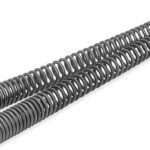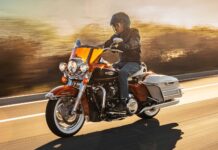As the name implied, the 1949 “Hydra-Glide” fork was The Motor Company’s first foray into the world of hydraulic suspension. While a first for American motorcycles, the technology was already 15 years old, having shown up on the Danish Nimbus in 1934 and more commonly on BMWs in 1935. What’s interesting (and typical of H-D) was that these forks were hardly innovative, yet basically done right from the beginning, serving Big Twins and their riders well until 1977… when most of the same thinking went into the Showa (Japanese) versions still with us today.
Not that basically right is perfect! I mean that the original “Glide” fork had large-diameter tubes (the largest at the time and for a long time to come), a reasonably proper method of fixing the axle, a sort of hidden brace in the form of a massively stout front fender bracket doing double duty, and last but not least those wide-set triple trees that have given the forks their most commonly used name today: Wide Glide. All of it—whether by accident or design—was mighty good stuff for a first attempt. All the same, the area where they proved most troublesome then, sadly, remains even now; namely, the hydraulic part!
Much of what makes a good front fork, like the Hydra-Glide, wasn’t really understood when the forks were originally launched. For proof, we need not look much further than the factory’s follow-up effort—the steel slider forks introduced on the K model (soon to be Sportster) some three years later. That first “narrow glide” (never a factory designation, by the way) showed all that was wrong with early hydraulic forks—heavy, flimsy, flexible, poorly sprung and with almost zero damping capability. In the factory’s defense, it should be noted (not without irony) that this front fork was patterned closely after the common British theme, but without most of the functional virtues some of those skinny front ends offered.
So, from the same manufacturer, we have examples of both the best and the worst of “state-of-the-art” some half a century ago. Flash forward all those decades and we see that almost all of the original virtues of the Wide Glide as we’ve known it have been borrowed and developed for nearly every motorcycle made today. In fact, almost the only popular variation was taking the same basic architecture of this fork and turning it upside down! Yet the so-called “inverted fork,” while having its advantages structurally over conventional forks, remains essentially a version of the same old hydraulic forks we’ve known for so long.
Don’t get me wrong—the design and development of the internals of hydraulic forks has been, if anything, even more impressive than the rest of a modern fork. That said, these mechanical refinements (such as cartridges, valves and better damper rods) all continue to function according to hydraulic principles that have decidedly not changed over the years. That’s why they are refinements, rather than breakthroughs.
What might be news to most riders is that the driving technology for many of these refinements (both structurally and hydraulically) has more to do with vast improvements in tires and brakes than overwhelming desire to improve ride quality. Ride quality, of course, can be pretty subjective; some want it as plush as a ’47 Buick and others as taut as a buckboard wagon. Still, regardless of preference, it begins with spring rate. Springs, you see, are the item that determines how far a suspension will travel when you hit a bump or dip as well as how much force it will take to get the suspension moving. The hydraulic part, on the other hand, is essentially what determines how fast the suspension moves. That is where the subtle but serious art of compromise seems to enter into any discussion of suspension performance.
Forks have had many a gadget built into them over the years to make spring rate variable and adjustable—to say nothing of the three types of springs they can employ to begin with. There are straight-rate springs, which take the same amount of force to move each and every inch of their travel. For example, if it takes 50 lbs of force to compress the spring one inch it will take another 50 lbs (100 lbs in total) to compress it the second inch and so on until the end of the travel. There are variable-rate (or “progressive,” if you prefer) springs that typically start out with relatively soft rates to allow a cushy ride for the first inch or so of travel, then get considerably stiffer as they reach the last inch or so at the end. (For the record, these are a bad idea for lowered bikes with not enough suspension travel to benefit from them.) Then, we have air (yup, air!) as the most adjustable and variable springing medium of all. A volume of air trapped in a fork tube increases its spring effect in the most accurate and geometric fashion imaginable. When the space it is trapped in is, let’s say, reduced by half due to fork compression, the spring rate is, in effect, increased almost instantly to four times as much as it was at rest. The trouble with both progressive and air springing is that it is very difficult to develop effective damping for them. Knowing all this, it becomes apparent there’s a lot going on, and most of it inconsistently, which makes getting that perfect ride quality pretty damned elusive. Even so, when and if you get it where you like it (mostly), there remains the issue of controlling what springs do. You may not appreciate this simple fact, but it becomes crucial when there’s a fairing hanging on that front end… and/or if your bike has been lowered. This is where damping becomes the primary variable.
Damping is precisely what the hydraulic elements in a fork are supposed to be doing. (You didn’t think the fork oil was in there just to keep things from rusting, did you?) Initially, it was only done to control what an impact would do when a bump made the fork compress… thus “compression damping.” About 30 years ago, some suspension engineer had the bright idea that controlling the action of the fork as it sprung back would be even better. He was right, and “rebound damping” was born! Today, all forks have some degree of both, but the thing that’s kinda been lost in the shuffle is this: Damping is tunable as well!
Look, whether your forks have old-school damping rods, the cartridge forks used on the Sportster Sport and the Dyna Sport about a decade back, the hybrid system (one damper rod and one cartridge) the factory used on baggers with fairings from 2003-2005, or even the newest set-up with control valves on top of the springs, they all use fork oil for the hydraulic functions of damping. The point being, in spite of (or perhaps because of) the increased sophistication of the innards in your forks (some with external adjustments for low-speed damping), you can still make a big difference in ride control by simply changing the amount, or viscosity—or both—of fork oil.
It seems a peculiar constant in Harley’s fork specifications (regardless of the particular design du jour) that H-D’s proprietary hydraulic fluids for that purpose remain unchanged and mysterious in the face of decades of improvement in the internal hardware. I mean, the factory goes to all the trouble of designing different springs (and damper rods and cartridges and valves) to tune the ride of every model, yet all of ’em are supposed to use the exact same stuff to make that hardware work… in the form of the ubiquitous, standard Type E fork oil? You could almost buy it, were it not for the equally strange and mysterious fork oil options they also offer (like Type B, Screamin’ Eagle Performance and Screamin’ Eagle Racing)… without telling you anything about them. Well, just in case anyone feels like trying to improve the action of their forks, I’ll tell ya a little something about Harley-Davidson fork oils (and some others as well).
First of all—forget any notions about weight when it comes to fork oils. Too many aftermarket brands are labeled as the same weight, yet are not the same in service. A much better guide is a viscosity rating measured in centistrokes (cSt) at two different temperatures. T’ain’t perfect, but it’s a much better way to compare actual results with fork oils. The centistroke thing is an accurate gauge of actual flow through a given orifice. The temperature thing (measured at 40 degrees centigrade and at 100 degrees centigrade) is a valuable indicator of the fluid’s performance and sometimes considerable variations in behavior at (call it) normal operating ranges and at maximum temps. (As one who vividly remembers watching the paint peel off hot shocks, I can tell you this information matters! A heavily loaded touring bike speeding along a washboard road can damn near boil the fork oil… for one example.) To say the results at the two extremes can be quite different is an understatement. You might find that one brand, type or, mostly, viscosity of fork oil is a significantly better performer for your style of riding than another, whether only slightly different in rating than H-D’s—or radically—the results are all that matter. Those results can be amazing, if you’re simply willing to fork around a little.
Most of us think that the key to great suspenders is in the springs… whether straight rate or progressive. It certainly starts there, since getting the right rating for the desired loads (and impacts) is the foundation. What isn’t so well understood (nor dealt with) is the damping side of the equation… of equal or perhaps greater importance to the end result.
Harley-Davidson branded fork oils are all made by Citco with state-of-the-art anti-foaming additives and so on. Heavier oils will slow damping and lighter fluids speed it up… simple as that. But… they do it differently at different temperatures—important to factor in when picking fork oil for improved damping. Here’s the pertinent poop on Material Safety Data Sheet (MSDS) specs for these “factory” proprietary fork oils:
Click on Chart to view larger PDF
* V< T— is a sort of “ratio” of the viscosity in cSt at 40c divided by the same thing at 100c. The lower the number the better, since it means more stabile performance at high-suspension temps. A ratio of “1” would mean the fluid performed exactly the same at all operating temperatures and conditions.
All fork oils are not created equal! (For chapter and verse, check H-D’s Racing Fork Oil! It has some truly weird properties and no relationship with street bikes… period!) So here are some more options, a few more “equal” to your particular task than others:
Click on Chart to view larger PDF





















